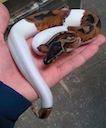» Site Navigation

1 members and 688 guests
Most users ever online was 47,180, 07-16-2025 at 05:30 PM.
» Today's Birthdays

» Stats

Members: 75,910
Threads: 249,115
Posts: 2,572,187
Top Poster: JLC (31,651)
Welcome to our newest member, coda
|
-
-
-
There are a couple of genetic "paradoxing" morphs just getting off the ground Atomic and Whitewash.
-
-
Registered User


Re: What's your experience with paradoxing?
 Originally Posted by Daigga

Are the odds of producing twins random in ball pythons, or could it be argued that it's genetic?
Twinning isn't super well understood even in humans where tons of money goes in to understanding it  If you find a line of bps that reliably produces twins, I'd LOVE to study them!!!!! If you find a line of bps that reliably produces twins, I'd LOVE to study them!!!!! 
from a human study (C.M. Little 2011):
"A twin pregnancy has a higher risk of fetal morbidity and mortality than a singleton pregnancy depending on the zygosity and chorionicity of the fetuses. (fraternal) Dizygotic twins originate from two separate ova that are fertilized by two different sperm and are no more alike than any two siblings, and (identical) monozygotic twins develop from a single fertilized ovum, develop from one zygote, and are genetically “identical.” Recent evidence has shown that “identical twins” are more genetically discordant than originally thought because of epigenetic factors (this stuff is neat, actually - usually in regards to disease symptoms). In addition, twins are more at risk for chromosomal abnormalities and congenital anomalies. In the last century, twins played and continue to play an important role in genetics research. Twin studies are the criterion standard for research on the importance of heritability and environmental influences on behavior and disease."
Super interesting stuff, really. Even crazier when you think of it in an egg! sharing a yolk?! So amazing!!!
-
-
Re: What's your experience with paradoxing?
Occurrence of double-yolked eggs in chickens.
http://www.fresheggsdaily.com/2013/0...uble-yolk.html
I do not have the reference handy, but there was a study done over 20 years ago about double-yolk eggs. As I recall, there was a correlation between the size of the bird and the probability of double yolk eggs.
But you also need genetics. A snake may be a chimera without showing any paradoxing because both embryos produce the same coloration. The two embryos that form the chimera need to be of obviously different colors to produce paradoxing. Mating albino to het albino is a good mating to produce paradoxes.
Genetics can affect the number of eggs a female can produce, too. Years back, I had two female bullsnakes about the same size. Both bred in captivity over several years. One never had more than 10 (big to huge) eggs in a clutch, while the other never had less than 20 (smallish) eggs per clutch. Neither produced twins, and both were normal colored mated to normal colored males. So I can't prove that any babies were chimeras.
-
 Posting Permissions
Posting Permissions
- You may not post new threads
- You may not post replies
- You may not post attachments
- You may not edit your posts
-
Forum Rules
|











 Reply With Quote
Reply With Quote
 If you find a line of bps that reliably produces twins, I'd LOVE to study them!!!!!
If you find a line of bps that reliably produces twins, I'd LOVE to study them!!!!! 
